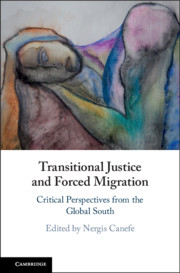Book contents
- Transitional Justice and Forced Migration
- Transitional Justice and Forced Migration
- Copyright page
- Dedication
- Contents
- Contributors
- Preface
- Acknowledgements
- Abbreviations
- In Lieu of an Introduction
- Part I The Past as the Memory of the Future
- Part II Law, Justice, and Hope
- 4 Transitional Justice, Displacement, and the Rights of the Young
- 5 Beyond Agreements
- 6 State-Based Truth Commissions
- 7 The Right of Return in Iraq
- Part III Ethics of Witnessing
- Index
- References
4 - Transitional Justice, Displacement, and the Rights of the Young
Retributive and Restorative Approaches in the Aftermath of the Rwandan Genocide
from Part II - Law, Justice, and Hope
Published online by Cambridge University Press: 24 October 2019
- Transitional Justice and Forced Migration
- Transitional Justice and Forced Migration
- Copyright page
- Dedication
- Contents
- Contributors
- Preface
- Acknowledgements
- Abbreviations
- In Lieu of an Introduction
- Part I The Past as the Memory of the Future
- Part II Law, Justice, and Hope
- 4 Transitional Justice, Displacement, and the Rights of the Young
- 5 Beyond Agreements
- 6 State-Based Truth Commissions
- 7 The Right of Return in Iraq
- Part III Ethics of Witnessing
- Index
- References
Summary
Balancing transitional societies’ need for justice against the best interests of children and youth is a difficult endeavor. The displacement of young people who, unaccompanied or with their families, are forced by conflict and human rights violations to flee their homes and communities represents an additional challenge in societies seeking to transition toward a more inclusive, sustainable peace. Transitional justice mechanisms, from special courts and tribunals to truth and reconciliation processes, must contend with the intricacies of respecting young people’s rights as they are affected by and participate in legal and nonjudicial proceedings. Specifically, effective efforts to combat impunity require an equitable and well-functioning juvenile justice system that also promotes rehabilitation and social reintegration. To this end, international standards must be reconciled with local cultural values, giving due weight to youngsters’ views. It is also worth bearing in mind that “members of the younger generations, especially those who grew up in exile – i.e., refugee camps managed by international aid organizations – and were exposed to alternative understandings of justice and reconciliation” do not always share the priorities of their older counterparts.
- Type
- Chapter
- Information
- Transitional Justice and Forced MigrationCritical Perspectives from the Global South, pp. 83 - 107Publisher: Cambridge University PressPrint publication year: 2019



